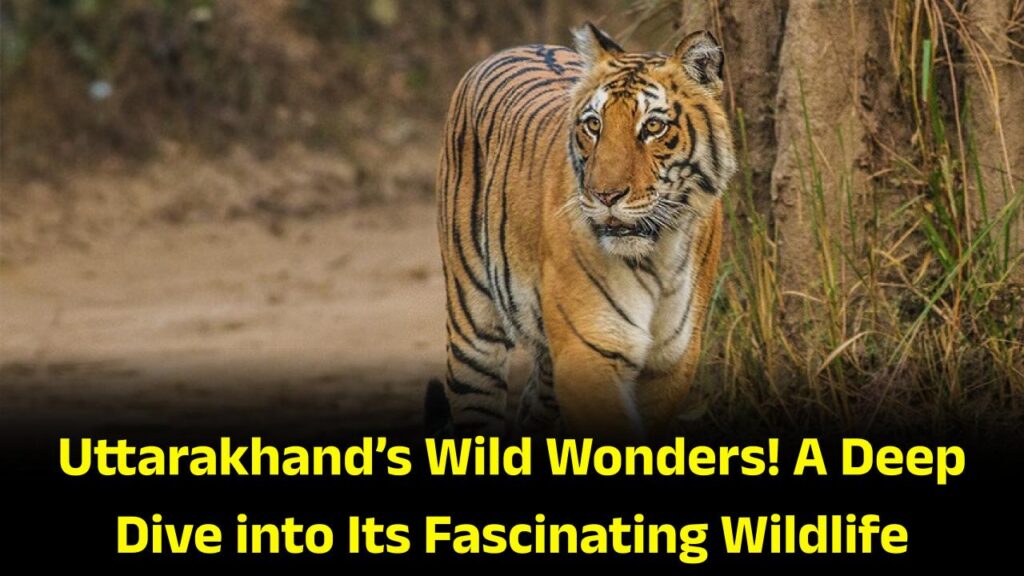
Uttarakhand, known as the Land of the Gods, is not just a spiritual haven but also a paradise for wildlife enthusiasts. Nestled in the Himalayan foothills, this northern Indian state boasts a rich biodiversity, making it home to some of the most fascinating and rare wildlife species in the world. From the elusive Snow Leopard to the majestic Bengal Tiger, Uttarakhand’s forests, national parks, and sanctuaries offer a sanctuary for nature’s most intriguing creatures.
Uttarakhand Wildlife Animals
| Feature | Details |
|---|---|
| Major National Parks | Jim Corbett, Rajaji, Nanda Devi, Gangotri, Valley of Flowers |
| Famous Wildlife Species | Bengal Tiger, Snow Leopard, Asiatic Elephant, Musk Deer, Himalayan Black Bear |
| Bird Species | Himalayan Monal, Pheasants, Eagles, Owls |
| Protected Areas | 6 National Parks, 7 Wildlife Sanctuaries |
| Best Time to Visit | October to June |
| Official Website | Uttarakhand Wildlife Department |
Uttarakhand is a treasure trove of wildlife and biodiversity, offering a rare blend of adventure and conservation. Whether you’re an avid wildlife photographer, a birdwatcher, or a nature enthusiast, this Himalayan state has something for everyone. By promoting sustainable tourism and conservation efforts, we can ensure that these fascinating creatures continue to thrive for generations to come.
Exploring Uttarakhand’s Most Fascinating Wildlife
1. The Majestic Bengal Tiger – King of the Jungle
The Bengal Tiger (Panthera tigris tigris) is perhaps the most iconic wildlife species of Uttarakhand. The Jim Corbett National Park, India’s first national park, was established in 1936 to protect this magnificent predator.
- Where to Spot: Jim Corbett National Park, Rajaji National Park
- Best Time to See: November to May
- Interesting Fact: Corbett National Park has one of the highest tiger populations in India, with over 250 tigers as per the 2022 census.
2. The Elusive Snow Leopard – The Ghost of the Mountains
The Snow Leopard (Panthera uncia) is an apex predator that thrives in the cold, rugged terrain of Uttarakhand’s high-altitude regions.
- Where to Spot: Gangotri National Park, Nanda Devi Biosphere Reserve
- Best Time to See: December to March (Winter months increase sightings)
- Interesting Fact: Snow leopards are solitary animals and are known to leap up to 50 feet in a single jump.
3. Asiatic Elephant – The Gentle Giant
Rajaji National Park is home to over 600 Asiatic Elephants (Elephas maximus indicus), making it one of the most important conservation zones for these gentle giants.
- Where to Spot: Rajaji National Park
- Best Time to See: March to July
- Interesting Fact: Elephants are highly intelligent and have excellent memory, which helps them navigate long migration routes.
4. Musk Deer – The Perfumed Treasure of the Himalayas
The Musk Deer (Moschus chrysogaster), an endangered species, is highly valued for its musk glands, which are used in perfumes and traditional medicines.
- Where to Spot: Kedarnath Wildlife Sanctuary
- Best Time to See: November to April
- Interesting Fact: Only male musk deer produce the valuable musk, making them a target for poachers.
5. Himalayan Black Bear – The Forest Wanderer
The Himalayan Black Bear (Ursus thibetanus) is a medium-sized bear species with a distinctive white patch on its chest.
- Where to Spot: Kedarnath Wildlife Sanctuary, Nanda Devi Biosphere Reserve
- Best Time to See: April to November
- Interesting Fact: Unlike other bear species, Himalayan Black Bears spend winters at lower altitudes instead of hibernating in high-altitude caves.
Birdwatcher’s Paradise: Avian Wonders of Uttarakhand
- Himalayan Monal (Lophophorus impejanus) – The state bird of Uttarakhand, known for its brilliant colors.
- Koklass Pheasant – A rare, high-altitude pheasant found in Binsar Wildlife Sanctuary.
- Brown Dipper – A fascinating bird that hunts underwater, found near fast-flowing Himalayan streams.
- Himalayan Griffon Vulture – One of the largest flying birds in the world, essential for ecosystem balance.
Top National Parks and Wildlife Sanctuaries in Uttarakhand
1. Jim Corbett National Park
- Established: 1936 (India’s first national park)
- Famous for: Bengal Tigers, Leopards, Elephants, Crocodiles
- Best Time to Visit: November to June
2. Rajaji National Park
- Established: 1983
- Famous for: Asiatic Elephants, Tigers, Leopards, Sloth Bears
- Best Time to Visit: March to July
3. Valley of Flowers National Park
- UNESCO World Heritage Site
- Famous for: Unique alpine flora, Snow Leopards, Musk Deer
- Best Time to Visit: July to September
4. Nanda Devi Biosphere Reserve
- UNESCO World Heritage Site
- Famous for: Snow Leopards, Himalayan Black Bears, Goral
- Best Time to Visit: May to October
Conservation Efforts and Challenges
Despite its biodiversity, Uttarakhand faces several conservation challenges:
- Poaching & Illegal Wildlife Trade: Animals like Musk Deer are poached for their valuable musk glands.
- Human-Wildlife Conflict: Encroachment into wildlife habitats leads to increased conflicts, especially with tigers and elephants.
- Climate Change: Rising temperatures and habitat destruction impact wildlife populations.
- Efforts Taken: The Uttarakhand government has initiated eco-tourism projects, stricter anti-poaching laws, and community-driven conservation programs.
Practical Wildlife Safari Tips
- Best Time to Visit: October to June (Avoid monsoon season due to park closures)
- Entry Permits: Always book permits in advance via Wildlife Uttarakhand
- What to Carry: Binoculars, camera, sunscreen, and light woolens for high-altitude safaris.
- Safety Rules: Follow your guide’s instructions, maintain silence, and avoid wearing bright colors.
FAQs About Uttarakhand Wildlife Animals
Q1. Which is the best wildlife sanctuary to visit in Uttarakhand?
A: Jim Corbett National Park is the best for tiger spotting, while Valley of Flowers is ideal for birdwatchers and nature lovers.
Q2. When is the best time to visit Uttarakhand for wildlife safaris?
A: October to June is the ideal period. Avoid the monsoon season as most parks remain closed.
Q3. Are there eco-tourism activities in Uttarakhand’s wildlife reserves?
A: Yes! Activities include birdwatching, nature walks, jeep safaris, and eco-lodges promoting sustainable tourism.










